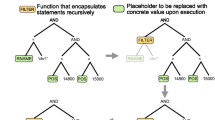Abstract
A convenient mechanism to refer to large biological objects such as sequences, structures and networks is the use of identifiers or handles, commonly called IDs. IDs function as a unique place holder in an application for objects too large to be of immediate use in a table which is retrieved from a secondary archive when needed. Usually, applications use IDs of objects managed by remote databases that the applications do not have any control over such as GenBank, EMBL and UCSC. Unfortunately, IDs are generally not unique and frequently change as the objects they refer to change. Consequently, applications built using such IDs need to adapt by monitoring possible ID migration occurring in databases they do not control, or risk producing inconsistent, or out of date results, or even face loss of functionality. In this paper, we develop a wrapper based approach to recognizing ID migration in secondary databases, mapping obsolete IDs to valid new IDs, and updating databases to restore their intended functionality. We present our technique in detail using an example involving NCBI RefSeq as primary, and OCPAT as secondary databases. Based on the proposed technique, we introduce a new wrapper like tool, called IDChase, to address the ID migration problem in biological databases and as a general platform.
Research supported in part by National Science Foundation grants CNS 0521454 and IIS 0612203.
Access this chapter
Tax calculation will be finalised at checkout
Purchases are for personal use only
Preview
Unable to display preview. Download preview PDF.
Similar content being viewed by others
References
PDB, http://www.pdb.org/
Swiss-Prot, http://www.ebi.ac.uk/swissprot/
Amin, M.S., Jamil, H.: FastWrap: An efficient wrapper for tabular data extraction from the web. In: IEEE IRI, Las Vegas, Nevada (2009)
Bhattacharjee, A., Jamil, H.: OntoMatch: A monotonically improving schema matching system for autonomous data integration. In: IEEE IRI, Las Vegas, Nevada (2009)
Chen, L., Jamil, H.M.: On using remote user defined functions as wrappers for biological database interoperability. IJCIS 12(2), 161–195 (2003)
Gupta, A., Mumick, I.S.: Maintenance of materialized views: Problems, techniques, and applications. IEEE Data Eng. Bull. 18(2), 3–18 (1995)
Jamil, H., El-Hajj-Diab, B.: BioFlow: A web-based declarative workflow language for Life Sciences. In: 2nd IEEE Workshop on Scientific Workflows, pp. 453–460. IEEE Computer Society Press, Los Alamitos (2008)
Liu, G., Uddin, M., Islam, M., Goodman, M., Grossman, L., Romero, R., Wildman, D.: OCPAT: an online codon-preserved alignment tool for evolutionary genomic analysis of protein coding sequences. Source Code for Biology and Medicine 2(1), 5 (2007)
Author information
Authors and Affiliations
Editor information
Editors and Affiliations
Rights and permissions
Copyright information
© 2009 Springer-Verlag Berlin Heidelberg
About this paper
Cite this paper
Bhattacharjee, A., Islam, A., Jamil, H., Wildman, D. (2009). IDChase: Mitigating Identifier Migration Trap in Biological Databases. In: Ranka, S., et al. Contemporary Computing. IC3 2009. Communications in Computer and Information Science, vol 40. Springer, Berlin, Heidelberg. https://doi.org/10.1007/978-3-642-03547-0_44
Download citation
DOI: https://doi.org/10.1007/978-3-642-03547-0_44
Publisher Name: Springer, Berlin, Heidelberg
Print ISBN: 978-3-642-03546-3
Online ISBN: 978-3-642-03547-0
eBook Packages: Computer ScienceComputer Science (R0)




